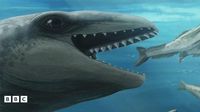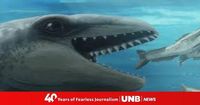On a windswept stretch of Victoria’s Surf Coast in Australia, a remarkable fossil discovery is rewriting the story of how whales came to rule the oceans. The find—a partial skull of a small, sharp-toothed whale—dates back an astonishing 26 million years, offering scientists a rare glimpse into the origins of today’s gentle baleen giants. The species, newly named Janjucetus dullardi, is already turning heads in the world of paleontology for both its unique features and what it reveals about whale evolution.
The fossil was uncovered in June 2019 by Ross Dullard, a local resident, during a stroll along the beach near Jan Juc on Wadawurrung Country. Realizing the significance of his find, Dullard donated the specimen to Museums Victoria, where a team of researchers began the meticulous task of preparing and studying it. Their work, published in the Zoological Journal of the Linnean Society on August 12, 2025, has since captured international attention. In a fitting tribute, the species was named Janjucetus dullardi in honor of its discoverer.
So, what made this ancient whale so special? For starters, Janjucetus dullardi was no ocean giant. Measuring just over two meters—about the size of a modern dolphin—it was a compact but formidable predator. With a short snout, large forward-facing eyes, and a jaw full of razor-sharp, slicing teeth, it would have been a fearsome presence in the shallow, warm seas of Oligocene Australia. “It’s essentially a little whale with big eyes and a mouth full of sharp, slicing teeth,” said Ruairidh Duncan, a PhD student at the Museums Victoria Research Institute and Monash University, who led the study. “Imagine the shark-like version of a baleen whale—small and deceptively cute, but definitely not harmless.”
Unlike the vast filter-feeding whales that cruise today’s oceans, Janjucetus dullardi belonged to a group known as mammalodontids. These early whales, which lived between 30 and 23 million years ago during the Oligocene Epoch, were distant, smaller relatives of modern baleen whales. Instead of baleen plates for filtering plankton, mammalodontids sported jaws lined with sharp teeth—more reminiscent of a shark than a blue whale. Only four mammalodontid species have ever been discovered worldwide, and this fossil is the third to be found in Victoria, following earlier finds in 2006 and 1939. That makes the region something of a paleontological hotspot.
The fossil itself is exceptionally well-preserved, containing not just the skull and teeth, but also delicate inner ear structures. Advanced microCT scanning revealed details of the cochlea, a key organ for hearing. This has allowed scientists to explore how Janjucetus dullardi might have sensed its environment—an ability crucial for both hunting and navigating the ancient oceans. As Dr. Erich Fitzgerald, senior curator of vertebrate palaeontology at Museums Victoria Research Institute and co-author of the study, put it, “This fossil opens a window into how ancient whales grew and changed, and how evolution shaped their bodies as they adapted to life in the sea.”
The discovery site itself—the fossil-rich Jan Juc Formation—dates to a time of global warmth and rising seas. According to the BBC, experts believe the coastal waters of Australia between 27 and 23 million years ago teemed with a variety of whales. “This region was once a cradle for some of the most unusual whales in history, and we’re only just beginning to uncover their stories,” Fitzgerald told the Australian Broadcasting Corporation. “We’re entering a new phase of discovery. This region is rewriting the story of how whales came to rule the oceans, with some surprising plot twists!”
What’s especially intriguing about Janjucetus dullardi is how it bridges the evolutionary gap between the toothed predators of the past and the gentle, filter-feeding giants of today. The fossil’s combination of sharp teeth and advanced ear structures provides key information on how early whales fed, heard, and moved in their watery environment. This, in turn, helps scientists understand the evolutionary pressures and adaptations that shaped the rise of modern whales. “The findings demonstrate the power of our collections to unlock stories that change the way we understand life on Earth,” said Lynley Crosswell, CEO and Director of Museums Victoria. “Thanks to the generosity of the public and the expertise of our scientists, Museums Victoria Research Institute is making globally significant contributions to evolutionary research.”
For paleontologists, the discovery also underscores the critical importance of southeast Australia in the story of whale evolution. As Fitzgerald noted, “If they were alive today, they would be as iconically Australian as a kangaroo.” The region’s fossil record is helping to fill in major gaps in scientific knowledge, providing clues not just about ancient whales but also about how marine life might respond to climate change in the future. The Oligocene Epoch, after all, was a period of significant environmental change, with warming temperatures and rising sea levels—a scenario that echoes many of today’s ecological challenges.
The story of Janjucetus dullardi is also a testament to the role ordinary citizens can play in scientific discovery. Dr. Fitzgerald emphasized the importance of public involvement, saying, “This kind of public discovery and its reporting to the museum is vital. Ross’ discovery has unlocked an entire chapter of whale evolution we’ve never seen before. It’s a reminder that world-changing fossils can be found in your own backyard.”
The research team, which includes scientists from Museums Victoria and Monash University, is continuing to study both newly uncovered fossils and long-unstudied specimens from the region. With each new find, they hope to shed more light on the evolutionary journey that transformed small, sharp-toothed hunters into the enormous, baleen-filtering whales we know today.
As paleontologists sift through the sands of Victoria’s coastline, one thing is clear: there are still many chapters left to uncover in the story of whale evolution. And with discoveries like Janjucetus dullardi, the narrative is sure to be full of surprises.



